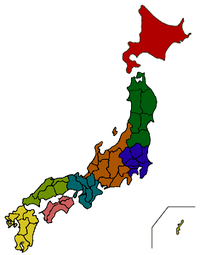Odawara Castle
| Odawara Castle 小田原城 | |
|---|---|
| Odawara, Kanagawa Prefecture, Japan | |
|
Odawara Castle | |
| Coordinates | Coordinates: 35°15′03″N 139°09′13″E / 35.25083°N 139.15361°E |
| Type | Hirayama-style Japanese castle |
| Site information | |
| Open to the public | yes |
| Site history | |
| Built | 1447, rebuilt 1633, 1706 |
| In use | Edo period |
| Demolished | 1872 |
| Battles/wars |
Siege of Odawara (1561) Siege of Odawara (1569) Siege of Odawara (1590) |
Odawara Castle (小田原城 Odawara-jō) is a landmark in the city of Odawara in Kanagawa Prefecture, Japan.
History
Odawara was a stronghold of the Doi clan during the Kamakura period, and a fortified residence built by their collateral branch, the Kobayakawa clan stood on the approximate site of the present castle. After the Uesugi Zenshū Revolt of 1416, Odawara came under the control of the Omori clan of Suruga.
They were in turn defeated by Ise Moritoki of Izu,[1] founder of the Late Hōjō clan in 1495. Five generations of the Late Hōjō clan improved and expanded on the fortifications of Odawara Castle as the center of their domains, which encompassed most of the Kantō region.
During the Muromachi period, Odawara Castle had very strong defenses, as it was situated on a hill, surrounded by moats with water on the low side, and dry ditches on the hill side, with banks, walls and cliffs located all around the castle, enabling the defenders to repel attacks by the great warriors Uesugi Kenshin in 1561 and Takeda Shingen in 1569. However, during the Battle of Odawara in 1590, Toyotomi Hideyoshi forced the surrender of the Late Hōjō clan through a combination of a three-month siege and bluff. After ordering most of the fortifications destroyed, he awarded the holdings of the Late Hōjō to Tokugawa Ieyasu.
After Ieyasu completed Edo Castle, he turned site of Odawara Castle over to one of his senior retainer, Ōkubo Tadayo, who reconstructed the castle in its present form on a considerably reduced scale, with the entire castle fitting inside what was the third bailey of the original Late Hōjō castle. Aside from an interruption from 1619–1685, during which time the Inaba clan extensively renovated the castle, the Ōkubo clan ruled over Odawara Domain from Odawara Castle until the Meiji Restoration.
Tokugawa Iemitsu, the 3rd Tokugawa Shōgun, visited Odawara Castle in 1634. The donjon built by the Inaba was destroyed in an earthquake in 1703, but was rebuilt by 1706.
The new Meiji government ordered the destruction of all former feudal fortifications, and in compliance with this directive, all structures of Odawara Castle were pulled down from 1870–1872, with the stone base of the former donjon becoming the foundation for a Shinto shrine, the Ōkubo Jinja, dedicated to the spirits of the generations of Ōkubo daimyō. In 1909, the Odawara Imperial Villa was constructed within the site of the former inner and second bailies. The Imperial Villa was destroyed by the 1923 Great Kantō earthquake. Repair work was made to the stone walls from 1930–1931, but with very poor workmanship. In 1935, two of the remaining yagura (which had been destroyed in the 1923 earthquake) were restored, but on a half-scale.
In 1938, the castle site was proclaimed a national historic monument,[2] with the area under historic preservation restrictions expanded in 1959, and again in 1976 based on further archaeological investigations.
In 1950, repairs were made to the stone base of the former donjon, which had been in ruins since the Great Kantō Earthquake, and the area was made into the Odawara Castle Park, which includes an art museum, local history museum, city library, amusement park and zoo. The three-tiered, five-storied donjon, the top floor of which is an observatory was rebuilt in 1960 out of reinforced concrete to celebrate the 20th anniversary of the proclamation of Odawara as a city. However, the reconstructed donjon is not historically accurate, as the observation deck was added at the insistence of the Odawara City tourism authorities. Plans have been discussed since the late 1960s on a more accurate restoration of the central castle grounds to its late Edo period format. These plans resulted in the reconstruction of the Tokiwagi Gate (常磐木門) in 1971, the Akagane Gate (銅門) in 1997, and the Umade Gate (馬出門) in 2009.
The reconstructed Odawara Castle was listed as one of the 100 Fine Castles of Japan by the Japan Castle Foundation in 2006.
The donjon was closed for renovation from July 2015 until April 2016. It reopened on 1 May 2016. Odawara City government donated all entry fees on the day of the re-opening to Kumamoto City government, to be put towards repairs to Kumamoto Castle that was damaged in the 2016 Kumamoto earthquakes.[3]
Literature
- Schmorleitz, Morton S. (1974). Castles in Japan. Tokyo: Charles E. Tuttle Co. pp. 144–145. ISBN 0-8048-1102-4.
- Motoo, Hinago (1986). Japanese Castles. Tokyo: Kodansha. p. 200 pages. ISBN 0-87011-766-1.
- Mitchelhill, Jennifer (2004). Castles of the Samurai: Power and Beauty. Tokyo: Kodansha. p. 112 pages. ISBN 4-7700-2954-3.
- Turnbull, Stephen (2003). Japanese Castles 1540-1640. Osprey Publishing. p. 64 pages. ISBN 1-84176-429-9.
External links
| Wikimedia Commons has media related to Odawara Castle. |
Notes
- ↑ Sansom, George (1961). A History of Japan, 1334-1615. Stanford University Press. p. 244-245. ISBN 0804705259.
- ↑ Agency for Cultural Affairs (Japanese)
- ↑ Hibino, Yoko Castles in Japan raise funds for quake-hit rival in Kumamoto May 2, 2016 Asahi Shimbun Retrieved June 29, 2016

